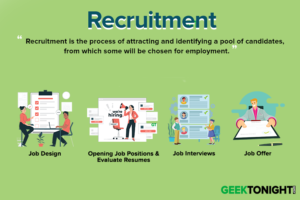In any business, its success depends on possessing the right people team to observe that everything gets done properly. The future of any enterprise lay in the hands of its manpower. Wrong selection of people can consume a measurable portion of the company’s profits and can even lead to the closure of the business. So a conscious effort must be taken to ensure the recruitment of the right candidate for the job in hand.
Table of Content
8 Effective Recruiting Measure to Reduce Negative Impact
Recruitment must be speedy, but a cautious process. A wrong move can have a disastrous impact on the undertaking. A few measures can be taken to reduce the negative impact. They are:
- Brand Image Creation
- Stating clear Definition of Employee Requirements
- Applications Receiving Sources
- Screening of Applications
- Selection Process
- Maintain a Candidate Pool
- Recruitment Policy
- Internal and External Sources
Brand Image Creation
A company that enjoys a good brand image will never have to take immense effort to find people. People will always be willing to work in a company that enjoys goodwill. A positive working relationship between the employees and the management, good monetary and non-monetary returns, greater chances for career growth through training programs, all can lure people to a company. Moreover, the stories by the existing employees have a bigger impact on the brand image.
Stating Clear Definition of Employee Requirements
Analyze the task which calls for new recruits to know the people requirement. The educational qualification, work experience, if any, number of people required, role in the organization and the team, job specification are all dependent on the job analysis. A wrong step can have a negative impact on the company’s image as well as its profitability.
Applications Receiving Sources
The employer has the option of using external or internal options to select the right candidate. External sources are the company website, print media, placement consultants, and internet. Large companies, enjoying brand value, can call for applicants by placing a requirement need in its website. Another option open is the print media which however, has a limited geographical reach.
Job sites on the internet like Naukri, Monster, etc., are faster and can reach people all over the world. Placement consultants, on the other hand, reduce the headache of going through the invitation process to a great extent. Another way of luring candidates is by providing incentives to the employees on successful references.
Reimbursement of travelling expenses incurred on commuting for the selection process, if any, must be informed beforehand. Many companies like Larsen and Toubro, ICICI reimburse the high cost incurred on commuting which has a positive effect on the prospective candidate.
Internal recruitment includes searching within the organization for prospective candidates. Companies like Wipro call for applicants within the organization through “wings within”, an intranet site, inviting applications from existing employees who long for a change of work within the organization. Small companies can select appropriate candidates by keeping close look at employees showing good prospects.
Screening of Applications
The next step is the screening of applications and selecting those which matches the job profile. The software can reduce the time spent on selecting resumes of people with the key requirements. If the prospective candidate applied through a placement consultant, one can be sure of his competency as the candidates will have gone through a screening process before being sent by the agency.
Selection Process
Blueprint of the entire selection process can reduce confusion. Companies may conduct tests to have an insight on the technical knowledge, communication skill, and general aptitude of the candidate. This might be followed by a group discussion which gives a clear idea on the interpersonal skills, leadership qualities and presentation skills of the candidate.
The next step is an interview. The interviewer must be given the proper training on how to recruit the right person. The questions to be asked must be decided in advance. The interview must give answers to the key skills of the interviewee, his professional and personal background, factors of interest in the new company and job, the reasons for quitting the previous employer, if any, his mobility depending on job requirements, and other vital information. The interviewer must be ready with the answers to the job-in-hand, monetary and non-monetary benefits allotted, his position in the managerial hierarchy, growth prospects, etc.
Maintain a Candidate Pool
Maintaining a list of applied candidates updating the reasons for the rejection for a particular post can help in the quick retrieval of suitable candidates in case of emergency. Time is a crucial factor in the competitive world. A well-drafted system of recruitment backed by properly trained staff can aid in the quick recruitment of people with excellent skills that can be utilized to improve productivity.
Recruitment Policy
It is derived from the company’s personnel policy of the same organization. Following factors should be considered in formulating recruitment policy:
- Government policies
- Personnel policies of other competing organization
- Organization’s personnel policies
- Recruitment sources
- Recruitment needs
- Recruitment costs
- Selection criteria & preferences.
Prerequisites of a Good Recruitment Policy
- It should be in conformity with its general personnel policies.
- It should be flexible enough to meet the changing needs of an organization
- It should be so designed as to ensure employment opportunities for its employees on a long-term basis so that the goals of the organization should be achievable; and it should develop the potentialities of employees.
- It should match the qualities of employees with the requirements of the work for which they are employed.
- It should highlight the necessity of establishing job analysis.
Internal and External Sources
First consideration should be give to the internal candidates, where there are no suitable candidates available within the organization, then external sources of recruitment should be considered.
Source of recruitment tells us, “Where are suitable candidates available in required number? Techniques tell us- “How they can be informed about the availability of job and organization”. Sources of recruitment include:
Internal Sources
These include personnel already on the payroll of an organization, that is, its present working force. Whenever any vacancy occurs, somebody from within the organization is upgraded, transferred, promoted or sometimes demoted.
- Present Permanent Employees: Organization consider the candidate from this source to higher level due to firstly availability of most suitable candidate for jobs relatively or equally to the external sources, secondly, to meet the trade union demands, thirdly to the policy of organization to motivate the present employees.
- Present Temporary or Causal Employees: Organization use this source to fill position of lower level.
- Retrenched or Retired employees: Dependent of Deceased, Disabled, retired and Present Employee.
Merit
- It improves the morale of employees, for they are assured of the fact that they would be preferred over outsiders when vacancies occur.
- The employer is in a better position to evaluate those presently employed than outside candidates.
- It promotes loyalty among the employees, for it gives them a sense of job security and opportunities for advancement.
- They are tried people and can be relied upon.
- It is less costly than going outside to recruit.
Demerits
- It often leads to inbreeding and discourages new blood from entering an organization.
- There are possibilities that internal sources may “dry up”, and it may be difficult to find the requisite personnel from within an organization.
- As promotion is based on seniority, the danger is that really capable hands may not be chosen.
External Sources
External sources include source outside the organization. They usually include:
- New entrants to the labor force i.e. young mostly inexperienced potential employees— the college students
- The unemployed—with a wide range of skills and abilities.
- Retired experienced persons such as mechanics, machinists, welders, accountants.
- Others not in the labor force, such as married women and persons from minority groups.
Other sources include:
- Campus Recruitment
- Private Employment Agencies/Consultant
- Public Employment Exchanges
- Professional Associations
- Data Banks
- Casual Applicants
- Similar Organizations
- Trade Unions
Merits
- External sources provide the requite type of personnel for an organization, having skill, training and education up to the required standard.
- Since persons are recruited from a large market, the best selection can be made without.
Human Resources Tutorial
(Click on Topic to Read)
Human Resource Planning
Human Resources Tutorial
(Click on Topic to Read)






